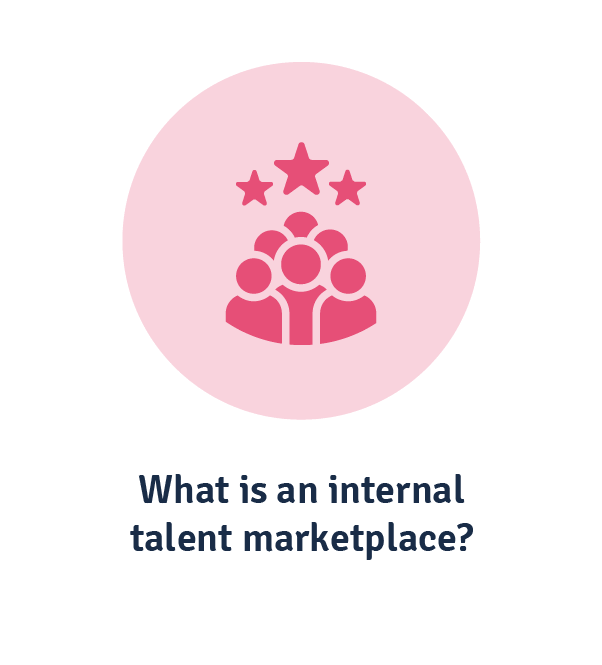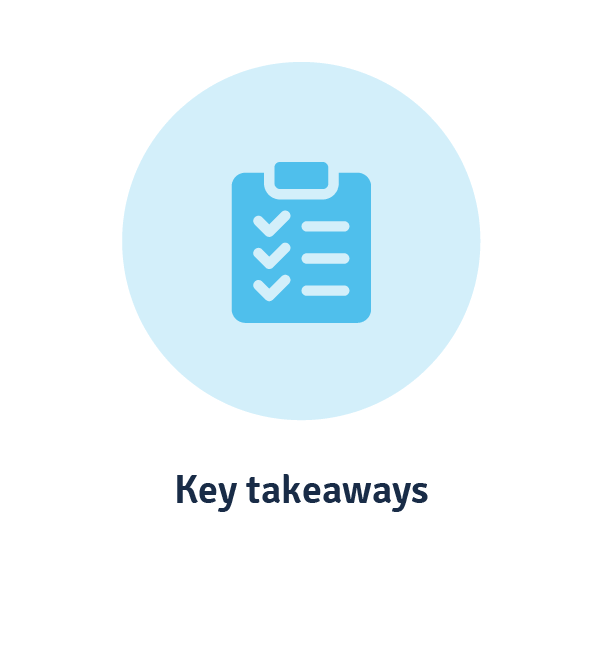It’s not always useful or efficient to wait for candidates to emerge from the external talent pool when you have positions that need to be filled. Especially for larger organisations, it’s often more economical to dip into the internal talent pool.
This is where the internal talent marketplace comes in. It’s a handy tool for understanding skills data and growth opportunities within your organisation — but is it right for your needs?
In this article, we’ll dive into the benefits of talent marketplaces and how enabling technology like talent marketplace platforms can assist in creating agile talent mobility.
What is an internal talent marketplace?
An internal talent marketplace is a two-way HR technology platform driven by artificial intelligence (AI) that matches internal candidates with jobs, projects, and hiring managers. Connections are formed based on interests, skills, and preferences that employees add to the system.
Why do you need an internal talent marketplace?
Think of internal talent marketplaces like an HR matchmaking app. It’s just that instead of matching people based on romantic interest, the tool catalogues skills, roles, and projects, and then pings people when a match is made.
That’s a handy function to have when you consider around just 20% of employees feel they can both meet their career goals where they’re currently employed and have the support of their organisation to do so. People leave organisations that don’t provide career growth, which is costly both financially and in terms of productivity (when you consider the time and resources taken to onboard new hires). Down the line, that’s resources taken away from other employee development initiatives, only perpetuating the cycle of lacking growth opportunities.
Harvard Business Review makes another compelling case in favour of the generalist. Without specialities, employees can afford more agility in their careers. What that means for an organisation is more workforce agility; generalists—given visibility of their skills and available jobs—can be more productive in a shorter time than specialists. It’s a tactic Google uses—hiring “smart generalists” who actively develop new skills and experiential learning through new job opportunities.
The keyword in that is visibility—because often talent is hiding in plain sight in your organisation. When you apply that knowledge to an open, internal marketplace, you work from the baseline all employees have the minimum prerequisites to do most jobs. And what does that mean? You’ve suddenly got a greater talent pool than you may have first thought, and one that’s more engaged with the work to be done in your organisation.
So, in short form, internal talent marketplaces help:
- Bridge the talent gap in external supply and demand
- Define employees’ current skills, the skills they need for their desired roles, and the gaps between the two
- Identify learning and career development opportunities for your employees
- Support succession planning activities, increasing career growth organisation-wide and employee retention
- Increase opportunities for internal mobility, creating a more agile workforce
- Reveal which employees are looking for new internal opportunities, thus feeding internal talent mobility.
How do you build a talent marketplace?
It’s worth noting that as talent management becomes harder at scale, internal talent marketplaces are best suited for enterprise organisations. Larger workforces need systemic, democratized talent processes given the smaller team of HR, L&D and/or development staff servicing them. (The median is roughly 1.5 HR employees per 100 people, making personalised pathways a tall ask for those HR employees.)
So, building an internal talent marketplace is not a matter of just getting HR to vet and manage a bunch of talent management tools. You need to:
- Define goals for the project
- Get buy-in from all stakeholders
- Implement (the right) technology
- Optimise and evaluate the process and tool.
Step 1: Define your goals
The first step is defining what you actually want to get out of a talent marketplace and what’s in it for the business.
We find doing a bit of soul-searching—ahem, asking a few key questions—is the best place to start.
- Why does your organisation need to have an internal talent marketplace? I.e., what is the pain point it’s solving and what is the expected return on investment?
- What skills does your organisation’s workforce currently have? Look to job scorecards, capability frameworks or gap analyses for a real-time understanding of available skills.
- What skills will your organisation need in the future?
- How does an internal marketplace drive business priorities?
- What jobs will your organisation need in the future? This one may be a little harder to predict, so if you’re struggling with it, stay in the weeds with the future skills and capabilities required.
Every decision you make during the talent marketplace-building process needs to answer at least one of these questions along the way. If you can’t back up your decisions with evidence of how they will answer any of these questions, then you aren’t meeting your defined goals.
Step 2: Gain buy-in
Now you need to get the support of stakeholders, including leaders and employees. This is not solely a human resources tool; it should be internally marketed as an almost self-service job board.
You need to consider how you frame a marketplace to avoid culture shock. Managers may feel they’re being taken out of the career development process; employees might think they’ll automatically get matched to their ideal job. How can you be sure of true objectivity in an age when internal mobility can be a taboo topic? You may design programs to go alongside your talent marketplace, like coaching, and therefore need buy-in from said coaches.
When building a business case to gain buy-in from your relevant stakeholders, you want to consider four things.
- What is the need? Not just the business need, but the reason for each stakeholder group to buy in. This could be cost-effectiveness, better career development, or greater insight into team skills.
- What is the problem? Talent leaders will understand what an abundance of people data is like to manage; employees may not. So, reframe it for each stakeholder. For example: a talent marketplace can help leaders better craft and recruit for job postings.
- What is the solution, really? What does an internal talent marketplace mean to these stakeholders? Is it another tool to manage, or a hub for career pathing and networking?
- Sell the vision. Stakeholders want to know this solution is the right one. Tell the story of two worlds with and without the marketplace, specifically the consequences of the latter.
You can bolster support with focus groups, showcases, success stories, or even by involving parties with the design and development process of the talent marketplace.
Step 3: Implement technology
This is the most labour-intensive part of the project, given it involves:
- Choosing a vendor
- Building a solution
- Implementing your solution.
While some enterprises have the resources to build their own platform, it’s fairly common to engage a vendor to do the heavy lifting.
Many vendors’ platforms make use of AI to connect employees’ skills with jobs and career pathways. Look out for fairly customisable platforms; being able to modify an interface to have your organisation’s branding will go a long way to encouraging user engagement.
We created the first performance learning management system (PLMS) with exactly this principle in mind. While not quite an internal talent marketplace, Acorn PLMS uses capabilities mapped to job roles and employees to provide learning opportunities that move the performance needle.
Within Acorn, you’re not only seeing the skills available in your workforce, but also the current level of proficiency they’re being performed at and a timeline for when employees will be performing at full capability.
Any project needs a team who are responsible for implementation and management. It’s valuable to have more than just HR staff on the team, if only in an advisory capacity. HR, of course, acts as technological and developmental support for the system and its users as well as strategy planners.
Think:
- Business leaders who are responsible for driving vision amongst the workforce.
- Talent leaders who have the job of maintaining current job postings and verifying matched talent.
You may also want to seek feedback from mentors or coaches within your organisation. If, say, they’re finding matches through the marketplace, then they can give insight into the accuracy of said matches, and therefore the efficacy of the system.
Remember when we said we wanted to avoid culture shock? This is a significant change management endeavour, and, as such, can be overwhelming. Sometimes it can pay to test talent strategies with a focus group before you roll it out to the masses, so you can iron out creases before they can cause mass panic.
Surveys for employees and hiring managers using the system will also give you an idea of:
- The platform’s accuracy in matching talent and roles
- Uptake and engagement with the marketplace
- Sentiment, namely if people find it impactful and valuable.
All of which is good information to take into the next step.
Step 4: Evaluate and optimise
Once you’ve implemented your internal talent marketplace software, it’s time for you to evaluate the effectiveness of the system.
Consider KPIs like retention, employee performance, engagement, and improvement to business process, as these measure the pain points we were talking about the begin with. If you can show tangible movement on those, executives are more likely to continue buying into—and therefore, funding—an internal talent marketplace.
That’s not to say you should only focus on the rosey things. Consider the setbacks or shortcomings you’ve found in your solution and its implementation. Not only will this build a stronger system for your organisation, but it shows that you’re taking on feedback and investing in the employee experience.
Part of this reflection is to build a sustainability plan. You need to continue to evaluate your talent marketplace for growth opportunities and optimise accordingly. This way, your organisation will be ready to find the right internal candidate no matter the changes that come about, whether it be cultural change in your workplace or wider change in the industry.
Do you really need internal talent marketplace?
The core of a marketplace is that enables your organisation to better understand the skills available in its workforce. That’s akin to identifying levers you can pull in uncertain times; i.e., when the external labour market is dry, or prevalent industry skills are changing (think about the impact of machine learning).
There is, at present, a trend towards skills-based organisations (SBOs). Both SBOs and talent marketplaces seek to make skills and work opportunities more visible, though very often neither do this through a strategic lens. By that, we mean visibility in talent marketplaces is often more valuable for employees; in skills-based organisations, it’s dependent on the structure of jobs. In either case, that’s static skills data, too.
Both are perfectly acceptable options for talent management, though they don’t connect skills or jobs to things like succession and development plans. That’s additional, manual work for HR. And the thing is, organisations are not defined by job roles. They are propelled by the bundles of tasks within those roles, tasks that are much more agile when things need to be restructured and optimised.
A platform like a PLMS enables you to consider people in terms of the capabilities they currently possess, and the capabilities you need them to have—and then give them the unique learning pathway they need to bridge that gap. Further, you can assess individual progress toward performance goals, giving you more granular insight into the readiness of employees. Handy when you’re considering moving people up job levels.
Remember those “smart generalists” we mentioned? They’re not served by static job postings. They’re satisfied by and developed into top talent with a system that gives them opportunities to grow into, and then the pathway to grow.
This way:
- Existing employees can qualify for new jobs, based on experience and tasks (and short-term project teams become viable talent solutions).
- Productivity gaps don’t fester while waiting for a candidate to be 100% ready.
- Critical capabilities move more fluidly through your organisation, rather than being siloed in functions.
- Managers are better empowered to design and develop their teams.
In short, a talent marketplace is not a silver bullet for issues relating to talent mobility and employee attrition. It’s only one potential option to consider—and one that’s really only worthwhile for enterprises.
Key takeaways
For large companies, an internal talent marketplace is a useful tool to develop talent rather than spend on external talent acquisition. A marketplace can also be a great value prop for retaining employees and reducing attrition.
Designing your own generally follows:
- Defining project goals
- Getting stakeholder buy-in
- Implementing technology
- Evaluating and optimising the tech and process.
While an internal talent marketplace gives employees and leaders alike better visibility of job opportunities, it doesn’t always provide the pathways to develop or grow into those opportunities. There may be other platforms that better suit talent mobility strategies, such as a PLMS, that are worth considering.
Related Reads on This Topic

How Talent Supply Chain Management Can Boost Productivity and Growth
A talent supply chain is the key driver behind a workforce delivering on organisational goals. Let’s take a look at how you can build one…

How to Identify Emerging Leaders and Why They’re Important for Succession Planning
Identifying and developing emerging leaders is not only important for the future of your company, but improving your current state…

What is Succession Planning and Why Is It Important for Business Strategy?
Succession planning can play a major role in ensuring productivity and workforce planning. Find out more about it and why it’s important…



